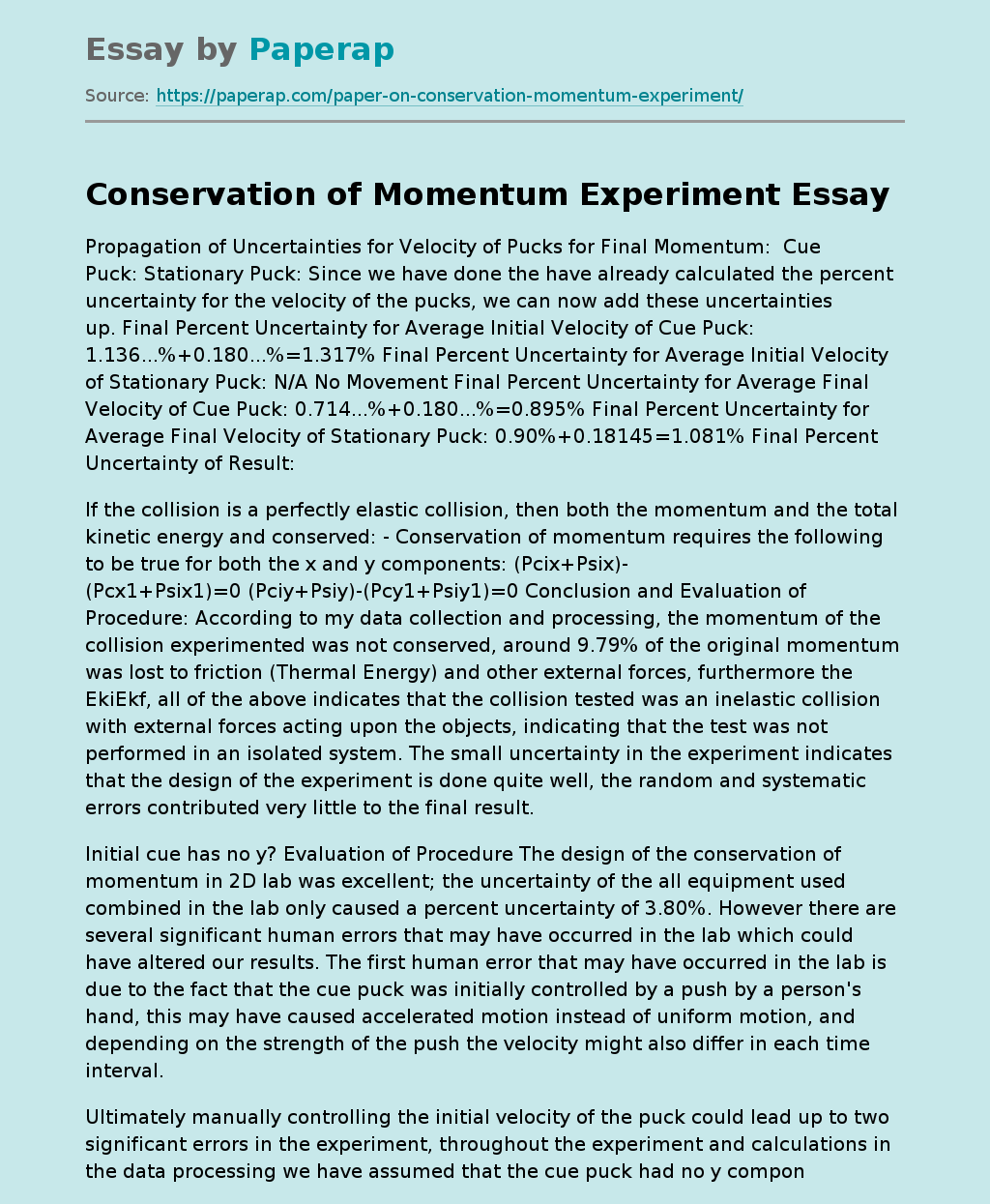Laboratory: Conservation of Momentum Experiment
Propagation of Uncertainties for Velocity of Pucks for Final Momentum.
Final Percent Uncertainty for Average Initial Velocity of Cue Puck: 1.136…%+0.180…%=1.317%
Final Percent Uncertainty for Average Final Velocity of Cue Puck: 0.714…%+0.180…%=0.895%
Final Percent Uncertainty for Average Final Velocity of Stationary Puck: 0.90%+0.18145=1.081%
If the collision is a perfectly elastic collision, then both the momentum and the total kinetic energy and conserved:
Conservation of momentum requires the following to be true for both the x and y components: (Pcix+Psix)-(Pcx1+Psix1)=0 (Pciy+Psiy)-(Pcy1+Psiy1)=0
Conclusion and Evaluation of Procedure: According to my data collection and processing, the momentum of the collision experimented was not conserved, around 9.
79% of the original momentum was lost to friction (Thermal Energy) and other external forces, furthermore the EkiEkf, all of the above indicates that the collision tested was an inelastic collision with external forces acting upon the objects, indicating that the test was not performed in an isolated system. The small uncertainty in the experiment indicates that the design of the experiment is done quite well, the random and systematic errors contributed very little to the final result.
The design of the conservation of momentum in 2D lab was excellent; the uncertainty of the all equipment used combined in the lab only caused a percent uncertainty of 3.80%. However there are several significant human errors that may have occurred in the lab which could have altered our results. The first human error that may have occurred in the lab is due to the fact that the cue puck was initially controlled by a push by a person’s hand, this may have caused accelerated motion instead of uniform motion, and depending on the strength of the push the velocity might also differ in each time interval.
Ultimately manually controlling the initial velocity of the puck could lead up to two significant errors in the experiment, throughout the experiment and calculations in the data processing we have assumed that the cue puck had no y components to it, but in reality, this is not true, it would be nearly impossible for the manually controlled puck to have travelled perfectly in a straight line, this flaw can be found on the data paper (dots made by the pucks), as the cue puck travelled in a curved linear fashion, this flaw could have also resulted an error in determining the collision angles of the cue puck and the stationary puck because its inaccurate to measure an angle from a curvy line.
The second problem that this maybe have caused is the measurement of the initial velocity of the cue puck, since we do not know when the accelerated motion stops and converts itself into uniform motion, we have to judge from the patterns of the dots made by the sparker to determine the average initial velocity of the cue puck, in reality none of the distances from any of the two dots from the data paper should never be the same if measured accurately, this factor could also be dependent on the strength of the push applied on the puck, the main reason behind this is that the time elapsed for the cue puck to travel is much too short for us to determine its exact initial velocity because it does not have a chance to slow down at all.
The third flaw in the lab is due to the nature of the test paper itself, the experiment was done on the air table to reduce the friction between the surfaces to a minimum, from my observations, the paper used for the experiment is fairly rough compared to printer paper, due to the nature of the paper there are several concentrated spots where many dots gathered imprinted by the sparker, this maybe an indication of the puck having a difficult time to move. The last flaw in the experiment may have occurred at the point of contact when the two pucks collide; frictions of the two puck surfaces could have easily slowed the pucks down and alter the final results.
Experiment Improvements:
The human errors can be reduced to a minimum if we use a type of a launcher that applies to equivalent strength to the puck which will allow the air puck to travel throughout the surface of the paper with uniform speed, the launch would also eliminate the excess y component and give us a more accurate result. The surface of the paper can be improved with the use of paper with smoother surfaces; this would produce a better data paper for us to do measurements with. To eliminate the friction at the point of contact, we could use ring magnets with opposite poles around the pucks, this would eliminate the contact of the two pucks and ultimately take friction away.
I think we could have done a combination of things better, if I were to design the lab again, I would create a apparatus with a camera mounted on top, which is programmed to take pictures for every time interval along with the improvements I have listed above, the pucks would be placed along the lines of a scale (Meter stick, measuring tape…etc.) There will also be a spark timer for the physical data. This way we will have a physical and digital data, we can always look back at the digital data (digital data should be more accurate) and compare it with the physical data, this will make the experiment nearly perfect.
Laboratory: Conservation of Momentum Experiment. (2017, Dec 05). Retrieved from https://paperap.com/paper-on-conservation-momentum-experiment/

